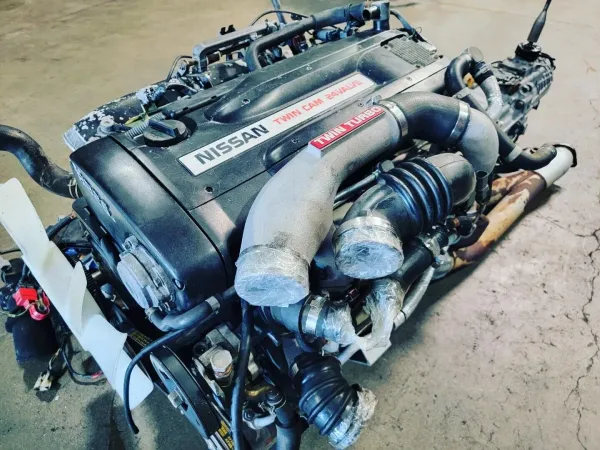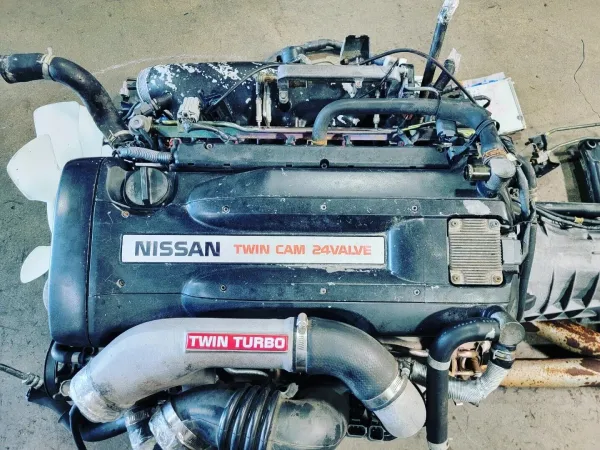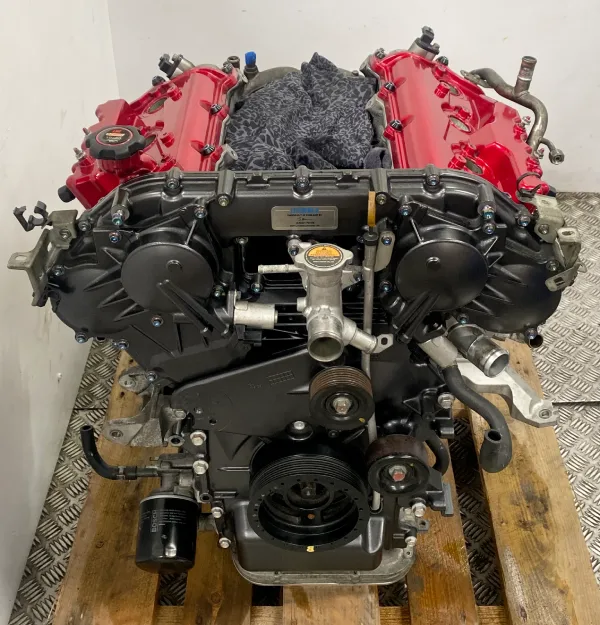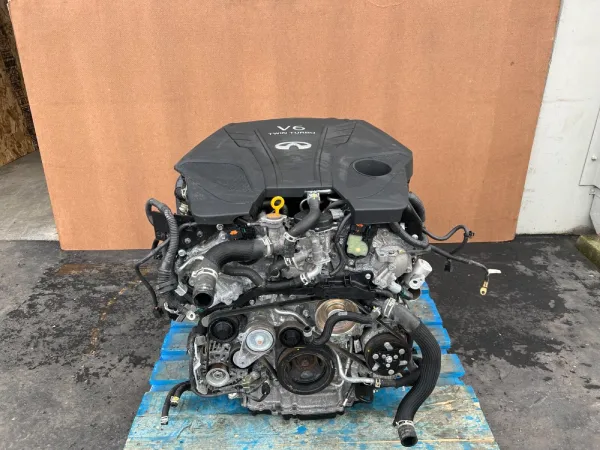For decades, Nissan has been pushing the boundaries of automotive engineering, creating some of the most powerful and innovative engines on the road. Their lineup of V6 and straight-6 motors have reached almost legendary status among gearheads. Models like the RB26DETT and VR38DETT show Nissan’s mastery of forced induction and cutting-edge tech.
So what gives Nissan engines their beastly performance? A few key factors:
Advanced Technology
Nissan stays ahead of the curve by packing their engines with the latest tech:
- Twin turbos boost power while reducing lag, like on the GT-R. The 300ZX and 370Z NISMO also benefit from twin-charged fury.
- Variable valve timing optimizes airflow for power or efficiency, and has been used extensively from the Fairlady Z to Titan trucks.
- Direct injection debuted on Nissans in the 90s, precisely spraying fuel for improved response.
- Variable compression ratios alter on the fly for the best blend of power and efficiency. Nissan VC-Turbos are the first production engines with this tech.
Robust Construction
Nissan motors are built from the ground up for performance applications:
- Forged crankshafts withstand extreme revs and torque loads. The GT-R’s VR38 has a forged crank strong enough for 1000+hp.
- Closed deck engine blocks add strength by surrounding the cylinders with more structure. Again embraced by the GT-R.
- Special coatings like those first used in the R35 GT-R improve cooling and durability.
- Dry sump lubrication keeps oil flowing during intense cornering when oil would normally slosh away from pickup points.
Purpose-Built Performance
Nissan engines are tailor-made for power:
- High-revving designs allow tremendous horsepower while maintaining a broad powerband. Many spin happily to 7500rpm and beyond.
- Lightweight internals reduce reciprocating mass. This allows faster revving and crisper throttle response.
- Excellent specific output generates big horsepower from relatively modest displacements thanks to great breathing.
- Strong turbo response reduces lag, with small responsive turbos and technologies like titanium turbine wheels.
- Free-flowing intake and exhaust systems let these motors inhale and exhale freely for maximum power.
With leading technology, robust construction, and a performance-first ethos, it’s no surprise Nissan mills have earned their reputation as engines of excellence. Their iconic 6-cylinder engines set the benchmark for Japanese performance.
Proven Motorsports Pedigree
From dominating Japanese touring car racing in the 1990s to battling the world’s best supercars at the Nürburgring today, Nissan performance engines are proven winners. The stresses and demands of motorsport force rapid evolution and technical innovation:
- Grueling endurance – Engines like the RB26DETT had to demonstrate the durability to complete marathon racing events like the Spa 24 Hours. Later, Nissan took on even longer challenges like the Nürburgring 24.
- All-out tuned specs – Safari Rally cars showed the immense power possible from an LB26DETT tuned to over 600hp. Group A and IMSA racers produced over 700hp from the basic RB block.
- Constant improvement – Racing allows rapid testing of new technologies like variable valve and ignition timing. This data then flowed back into production engines.
- Lightweight design – Shaving off grams in components like pistons and conrods makes a big difference on track. Engineers were constantly striving for greater performance through reduced mass.
This intensive development in the white heat of racing resulted in production engines of exceptional performance and durability.
The RB26DETT – Godzilla Roars to Life

No discussion of legendary Nissan engines is complete without the mighty RB26DETT. Powering the R32 Nissan Skyline GT-R, this brilliantly engineered straight-six was the shining star of Nissan’s motorsports efforts through the 1990s. It also gained near-mythical notoriety among tuners for its immense power potential.
The RB26 represented an engineering coup for Nissan. As Japanese car companies recovered from the economic downturn of the 1970s, Nissan wanted a high-performance halo car to re-establish their credentials. They found the answer in the RB26 – an advanced 2.6L straight-six specifically designed for Group A racing homologation.
Group A rules required manufacturers enter production-based cars, meaning engines had to be mass-produced street designs. But Nissan engineered the RB26 to be a racing engine first and foremost. The street cars were simply a means to compete on track.

Right from the outset, the RB26 embodied cutting-edge tech:
- Twin ceramic turbochargers – Huge for the time at 17cm, these ceramic-turbine units reduced turbo lag while allowing more boost.
- Air-to-air intercooler – Lowered intake temps for more power and reliability under boost.
- DOHC 24-valve head – Four valves per cylinder breathed far better than conventional designs of the era.
- Continuously variable valve timing – Altered intake cam timing based on load and RPM for a broad torque curve.
- Parallel twin-scroll turbos – Divided exhaust pulses energy more evenly at the turbine wheel for faster spooling.
But it was the RB26’s stout internal components that pushed output higher:
- Large ports and valves – Allowed tremendous airflow into cylinders. Intake valve diameter was an enormous 34mm.
- Forged crankshaft – Built to withstand the engine’s 7600 RPM redline. Extremely strong yet lighter than a cast crank.
- Full floating piston pins – Reduced stresses on the connecting rods at high RPM.
- Dry sump lubrication – Maintained oil pressure during hard cornering when oil would otherwise pool away from pickup points.
In road-going trim, the RB26DETT produced a then-absurd 276hp, completely eclipsing contemporary rivals. But it was in racing specification that Godzilla truly roared.
Constant development for competition use saw power pushed far beyond road car specifications. One famous example was the 1989 Group A “Super Spec” R32 GT-R homologation special. Officially rated at just 280PS to meet Group A requirements, its real output was rumored to be as high as 600hp!
Equipped with this highly-tuned race RB26, the R32 GT-R began humiliating vastly more powerful cars, earning the nickname “Godzilla”. It won 29 straight victories in the Japanese Touring Car Championship between 1988-1993 and four consecutive championships. The GT-R was simply that much better engineered than the opposition. When race-tuned, the RB26 could sustain power figures thought impossible from 2.6 liters.
As Group A wound down in the mid-90s, many RB26s and other tuned race engines found their way into enthusiast hands. Now in unrestricted form, drag racers and tuners began unlocking truly monster power from the RB26 – 700, 800, even 1500hp in some cases!
This immense tuning potential is a testament to the RB26’s overbuilt design. Everything from its stout bottom end, strong flowing head, and advanced technologies like VCT and parallel twin turbos make the RB26DETT one of the best high-performance engines ever produced.
VR38DETT- The New Performance Flagship

When it came time to launch the R35 Nissan GT-R supercar in 2007, Nissan wanted an engine befitting the legend. Their answer was the VR38DETT – an all-new 3.8L twin-turbo V6 created exclusively for the GT-R. Like the RB26 before it, the VR38DETT would showcase Nissan’s expertise in high-performance powertrain engineering.
Many consider the VR38DETT the pinnacle of Japanese performance engines. It demonstrates the immense gains in technology and potency since the RB26’s introduction over 15 years earlier. Yet it retains that same racing-derived DNA at its core.
The GT-R’s mandate was to blended unparalleled performance with daily-driver refinement. The VR38DETT achieves this balance beautifully. Finesse and fury in one refined package.
While a clean sheet design, the VR38DETT incorporates lessons learned from decades of motorsports success:
- Compact, lightweight and narrow for optimum packaging while reducing mass wherever possible.
- High compression – Run at up to 11.0:1 thanks to knock-resistance from direct injection cooling.
- Plasma transferred wire arc cylinder liners – Reduces friction and improves cooling. First mass production use of PTWA liners.
- Rigid closed deck block – Cylinders supported on five sides for strength. Shared with race-derived VQ V6 design.
- High flow cylinder heads – Straight intake ports, large valves and variable cam timing enable tremendous airflow.
- IHI turbochargers – Low-lag twins featuring a titanium impeller and turbine wheel for rapid spool-up.
This cutting-edge package resulted in 485hp and 434 lb-ft torque from the showroom. But like the RB26DETT, immense tuning potential lay hidden within:
- Beefy internals – Forged crank and rods, as well as sodium-filled exhaust valves handle increased pressures.
- Strong flowing heads – Allow big power gains just by opening up the breathing without radical engine work.
- Turbo-friendly layout – Twin smaller turbos spool faster and generate less backpressure than a single, large unit.
As a result, the VR38DETT can safely produce over 800hp with simple bolt-on mods. And when built fully, it’s been tuned to four-digit horsepower figures!
Yet at the same time, it’s tractable and smooth around town – a 1,000hp luxury coupe. This breadth of ability is a testament to Nissan’s talents of engineering and refinement.
VR30DDTT – The Modern Powerhouse

While the GT-R grabs the headlines as Nissan’s performance flagship, the brand has quietly developed an all-new performance motor for its sports cars – the VR30DDTT.
First introduced in the Infiniti Q60 400 Red Sport in 2016, the VR30DDTT shares some key technologies with the GT-R’s VR38, albeit in a more compact and affordable package. It serves as an impressive demonstration of how innovations pioneered in Nissan’s halo models eventually filter down to everyday sporty cars.
The VR30DDTT packaging is distinctly modern in approach:
- Downsized 3.0L displacement – Combined with turbocharging to reduce mass while maintaining power.
- Direct injection – Gives benefits to power, economy and emissions over port injection.
- Dual injectors – Features both direct and port injection for optimal flexibility.
- Twin turbochargers – V6 configuration allows the turbos to be packaged tightly in the cylinder banks for fast spool-up.
- Variable compression ratio – A world first in a production car. Alters the compression from 8:1 up to 10.5:1 to balance power and efficiency.
- Integrated exhaust manifold – Shorter path to the turbos for reduced heat loss and quicker turbo response.
This advanced array of technology gifts the VR30DDTT a unique blend of qualities:
- Efficiency – Up to 19/26 mpg city/highway despite producing 400hp in top trim Red Sport models. VCR allows Atkinson cycle operation under light loads.
- Packaging – Compact enough to be mounted transversely in the Q60 and the latest Z sports car. Helps optimize weight distribution.
- Powerband – Nearly flat torque curve from just 1500 rpm all the way to 6400 rpm redline. Punchy at low revs yet loves to run up to the limiter.
- Tunability – BorgWarner turbochargers, robust internals and strong cylinder heads give huge tuning potential. Over 700hp shown by intrepid tuners!
- Refinement – Excels at real-world drivability thanks advanced technologies like hydraulic engine mounts that cancel unpleasant vibrations.
In many respects, the overachieving VR30DDTT is the spiritual successor to famed motors like the RB26DETT and VR38DETT. It brings a distinctly Nissan blend of usable power, clever technology, and tuning potential to a new generation. Even in standard form, the VR30DDTT is mightier than the storied VG30DETT that powered the revered Z32 300ZX Turbo back in the 1990s. Proof that Nissan’s expertise in powertrains continues to evolve and impress.
The Future – Electrification and the E-Power Revolution
Looking to the future, Nissan is leveraging their powertrain expertise into the world of electrification. As emissions regulations tighten globally, Nissan is ensuring it remains at the technological forefront with advanced hybrid, battery electric, and unique range-extender powertrains.
Headlining these efforts is Nissan’s revolutionary E-Power system. Unveiled in 2016, E-Power represents a novel approach to electric mobility. It consists of an electric motor which supplies drive power. But unlike a conventional EV, motive force comes from a gasoline engine mounted separately from the transmission. This acts as an onboard generator, charging the battery pack as needed to power the motor. A regenerative braking system also tops up the batteries, while excess energy can be sent to the motor for a boost effect.
In essence, the brilliance of E-Power is packaging a Nissan electric drivetrain into a familiar serial hybrid configuration. This provides several key advantages:
- All the instant torque and smoothness of an EV powertrain. The electric motor is the sole means of providing drive.
- The isolation of engine noise with the ICE operating independently from the drive motor. This enhances refinement.
- No range anxiety thanks to the onboard engine-generator. Provides charge exactly when needed.
- Significantly better fuel economy than a traditional internal combustion engine vehicle.
Nissan sees E-Power as an ideal stepping stone to full EV adoption for markets not quite ready to take the plunge into battery-only vehicles. As of 2022, the Note hatchback designed for the Japanese market offers the most refined execution of E-Power yet. But the technology will soon roll out to a host of Nissan models globally, helping the brand achieve its sustainability goals.
In Summary
Across its history, Nissan has demonstrated an exceptional mastery of powertrain engineering. Time after time, they have developed segment-leading engines that redefine just what an automobile powerplant can achieve.
From the race-bred RB26DETT that earned Godzilla fame to the high-tech VR38DETT supercar motor, Nissan engines rightfully earn respect among enthusiasts. Combining cutting-edge technologies, robust designs, and racing-influenced development, Nissan V6 and straight-6 mills represent the pinnacle of Japanese performance engineering.
Yet Nissans are more than just powerhouses. Their broad abilities also make them remarkably refined daily drivers, a testament to Nissan’s holistic approach to engineering. Looking forward, Nissan also leads in the field of electrification with innovative hybrid and EV solutions like its novel E-Power drivetrains.
After over 80 years and hundreds of different engines, Nissan’s commitment to developing segment-leading powertrains remains stronger than ever. With their legacy of innovation and dominance, Nissan engines will no doubt continue as benchmarks for power and performance for decades to come.
Engineering Coordinator with 5+ years of experience in the automotive manufacturing industry. Currently supporting vehicle development and new model launch activities at Honda Development and Manufacturing of America. Skilled at managing engineering teams, overseeing prototype builds, coordinating testing, and driving continuous process improvements. LinkedIn








